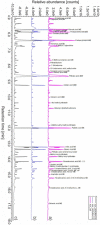How Can Ozone and Relative Humidity Affect Artists' Alkyd Paints? A FT-IR and Py-GC/MS Systematic Study
- PMID: 35566997
- PMCID: PMC9101010
- DOI: 10.3390/polym14091831
How Can Ozone and Relative Humidity Affect Artists' Alkyd Paints? A FT-IR and Py-GC/MS Systematic Study
Abstract
Knowledge of the chemical-physical reactions that determine the main degradation behaviour of artists' alkyd paints represents one of the main problems within the museum exhibitions. The collection and interpretation of these data on degradation phenomena, especially after ozone exposure at different relative humidity values, can be useful for their conservation needs. Therefore, a systematic investigation of these materials may help achieve this goal. Firstly, surface-level identification of the main functional groups of ad hoc created and aged alkyd paints was performed using attenuated total reflection Fourier-transform infrared spectroscopy (ATR-FTIR). Subsequently, these paints were investigated by pyrolysis-gas chromatography and mass spectrometry (Py-GC/MS), allowing for precise bulk identification of the organic compounds before and after accelerated ageing. A first successful attempt to provide quantitative Py-GC/MS data on alkyd-based paints is here presented and discussed. Comparing the results, it was possible to obtain new insights into the degradation behaviour of alkyd paints when exposed to ozone, allowing us to devise specific preventive and conservation strategies for these artistic materials.
Keywords: Py–GC/MS; alkyd paints; degradation behaviour; ozone; relative humidity.
Conflict of interest statement
The authors declare no conflict of interest.
Figures





Similar articles
-
Multi-Analytical Investigations of Andy Warhol's "Orange Car Crash": Polymeric Materials in Modern Paints.Polymers (Basel). 2022 Feb 7;14(3):633. doi: 10.3390/polym14030633. Polymers (Basel). 2022. PMID: 35160622 Free PMC article.
-
Separation techniques for the analysis of artists' acrylic emulsion paints.J Sep Sci. 2004 Mar;27(4):263-74. doi: 10.1002/jssc.200301638. J Sep Sci. 2004. PMID: 15334913
-
A Multi-Analytical Approach for Studying the Effect of New LED Lighting Systems on Modern Paints: Chemical Stability Investigations.Polymers (Basel). 2021 Dec 17;13(24):4441. doi: 10.3390/polym13244441. Polymers (Basel). 2021. PMID: 34960992 Free PMC article.
-
Screening of synthetic PDE-5 inhibitors and their analogues as adulterants: analytical techniques and challenges.J Pharm Biomed Anal. 2014 Jan;87:176-90. doi: 10.1016/j.jpba.2013.04.037. Epub 2013 May 6. J Pharm Biomed Anal. 2014. PMID: 23721687 Review.
-
Poly(Vinyl Acetate) Paints: A Literature Review of Material Properties, Ageing Characteristics, and Conservation Challenges.Polymers (Basel). 2023 Nov 7;15(22):4348. doi: 10.3390/polym15224348. Polymers (Basel). 2023. PMID: 38006073 Free PMC article. Review.
Cited by
-
Data Fusion Approach to Simultaneously Evaluate the Degradation Process Caused by Ozone and Humidity on Modern Paint Materials.Polymers (Basel). 2022 Apr 27;14(9):1787. doi: 10.3390/polym14091787. Polymers (Basel). 2022. PMID: 35566956 Free PMC article.
References
-
- Borgioli L. I Leganti nell’Arte Contemporanea. Nardini Editore; Firenze, Italy: 2020.
-
- Learner T., Smithen P., Schilling J.W., Krueger M.R. Modern Paints Uncovered, Proceedings from the Modern Paints Uncovered Symposium. Getty Publications; Los Angeles, CA, USA: 2007.
-
- Ploeger R., Chiantore O. Characterization and Stability Issues of Artists’ Alkyd Paints. Smithson Contrib. Mus. Conserv. 2012;3:89–95.
-
- Learner T. The Analysis of Synthetic Paints by Pyrolysis-Gas Chromatography-Mass Spectrometry. Stud. Conserv. 2001;46:225–241.
LinkOut - more resources
Full Text Sources
Miscellaneous

